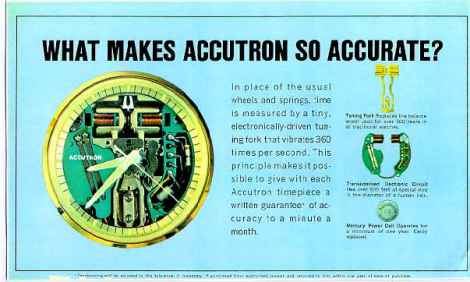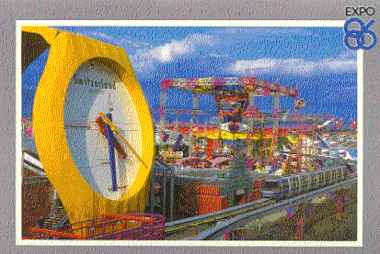|
"...Mass production of fine
watches is possible only through careful testing of every single
piece that goes into their manufacture. It is demanding work.
Some of the parts -- minutely fine screws -- are so tiny that
to the naked eye they resemble mere specks of dust. it takes
about 50,000 of them to fill a thimble.
Although Switzerland produces
annually almost 45,000,000 timepieces, there is no low-quality
'mass production' in Swiss watchmaking. Every single timepiece
is the individual proof of Swiss skill..."
Advertising brochure: "The
Swiss Watch Pavilion, 1964/1965 New York World's Fair"
|
|
|
As the 1964/1965 New York World's Fair
drew to a close, the Space Age was about to dawn on the Swiss
watchmaking industry. Among the items buried in the Westinghouse Time Capsule at the New York Fair
on October 16, 1965 was a new type of watch developed by Bulova,
an American watchmaker. The name of this new watch was the "Accutron"
and it was regulated by a tiny tuning fork.

An Accutron Advertisement
The Accutron appeared on the market in
late 1960 and was marketed at the Fair with advertisements appearing
in the Official Guide. It was quite popular until its
technology was replaced by breakthroughs in quartz technology
in 1969. The Japanese watchmaker Seiko was quick to market these
new quartz watches with resounding success.
|
|
"...In the wake of the quartz
boom, the mechanical watch was soon decried as old hat and disappeared
from almost every brand's range. The advent of microelectronics
rendered the traditional craft of watchmaking obsolete and at
the same time made production much more efficient.
The result was that 60,000 watchmakers
lost their jobs during the almost decade-long quartz crisis.
And along with them, the special machines they used and many
already finished mechanical watch components were discarded.
A fatal mistake, as would become apparent after the quartz euphoria
had subsided.
Expert watchmakers in retail
shops were suddenly degraded to the roll of battery changers
. And when quartz watches from the Far East became even cheaper
than the batteries need to run them, the whole industry had reached
rock bottom."
"AS TIME GOES BY..."
Swissair Gazette Magazine, in-flight magazine of Swissair,
March 2000
|
|
|
The turnaround for the Swiss watchmaking
industry came in 1983 with the introduction of the "Swatch"
-- the inexpensive plastic watch which made the analog display
with hands popular with consumers again. In 1986, the Swiss prominently
featured this industry life saver on their pavilion at Vancouver's
Expo86.

Swiss Pavilion at Expo86,
Vancouver, B.C., Canada, 1986
What an interesting paradox -- the Space
Age versus Old World Craftsmanship. It took the Swiss watchmaking
industry fifteen years (and its near demise) to prove that Space
Age technology isn't necessarily superior to innovation, quality
and craftsmanship!
|
|